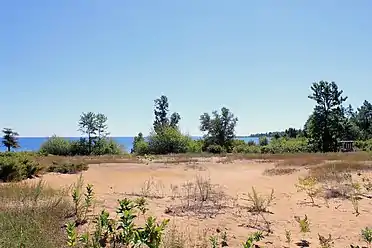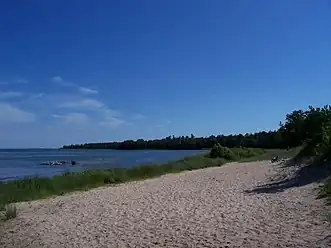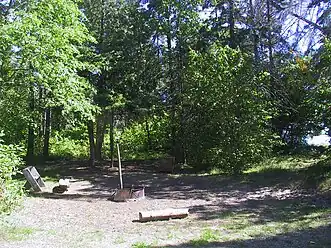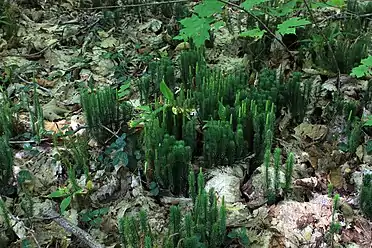| Newport State Park | |
|---|---|
IUCN category V (protected landscape/seascape) | |
 | |
  | |
| Location | Door, Wisconsin, United States |
| Coordinates | 45°14′6″N 86°59′39″W / 45.23500°N 86.99417°W |
| Area | 2,373 acres (9.60 km2) |
| Authorized | by the county board on December 11, 1961[1] |
| Governing body | Wisconsin Department of Natural Resources |
Newport State Park is a 2,373-acre (960 ha) Wisconsin state park at the tip of Door Peninsula near Europe Lake. Protecting 11 miles (18 km) of shoreline on Lake Michigan, Newport is Wisconsin's only wilderness-designated state park. The park is open year-round[2] and can be accessed via WIS 42.
History
In 1946, the State Planning Board and the Wisconsin Conservation Department recommended the area as a place to develop a park. In 1958 the National Park Service and the Wisconsin Conservation Department also recommended the area. On September 24, 1964, the park was established as Europe Bay State Park. In August 1970, the name was changed to Newport State Park to reflect a park expansion. In 1970 the day use area and entrance road were constructed. Campsites were completed in the summer of 1973.[3] On April 25, 1978 a tract of land between Europe Lake and Europe Bay was added to the park.[4]
In 2017, the International Dark-Sky Association named Newport a Dark Sky Park.[5]
Air pollution monitor

The only public air pollution monitor in the county is located in Newport State Park.[6] Most air pollution reaching the station comes from outside the county. This map shows how air travels to the monitoring station. Because the station is near the shore, only the red lines (which show the lower air currents) meaningfully depict the path of ozone to the monitor. As shown on the map, these lower air currents carry polluted air from major urban areas. Farther inland, however, the air from higher up mixes more, so all color lines are significant when tracing the path of air pollution further inland, and these higher air currents (shown in green and blue) blow in from cleaner, mostly rural areas.[7]
Climate
| Europe Bay | ||||||||||||||||||||||||||||||||||||||||||||||||||||||||||||
|---|---|---|---|---|---|---|---|---|---|---|---|---|---|---|---|---|---|---|---|---|---|---|---|---|---|---|---|---|---|---|---|---|---|---|---|---|---|---|---|---|---|---|---|---|---|---|---|---|---|---|---|---|---|---|---|---|---|---|---|---|
| Climate chart (explanation) | ||||||||||||||||||||||||||||||||||||||||||||||||||||||||||||
| ||||||||||||||||||||||||||||||||||||||||||||||||||||||||||||
| ||||||||||||||||||||||||||||||||||||||||||||||||||||||||||||
The climate of Newport is humid, microthermal with cool summers and with an even monthly precipitation distribution. The climate of the park is modified considerably by its close proximity to Lake Michigan and Green Bay. This is reflected in the fewer number of days with extremely high or low temperatures than are common for that latitude. Spring and early summer are retarded by the surrounding cool water; summers are mild and pleasant. Relatively warm lake water delays the first freeze in fall, and the winters are cold. The lake influence is also seen in higher average cloudiness and lower percentage of sunshine than is found at stations located further away from the lake.[9]
From data compiled in 1974, prevailing winds are from the northwest through the southwest, with the exception of early spring when northeast winds dominate. April and November are the windiest months with averages of 12 miles per hour. Speeds in excess of 60 miles per hour can be expected to occur in seven of ten years. The highest speeds are usually from the west or southwest.[9]
As of figures available in 1974, the percentage of possible sunshine has averaged about 40 percent for November and December and 60 percent or more from May through September. The remaining months average between 50 and 60 percent. The yearly average temperature at Sturgeon Bay is 43.8 °F. The average daily maximum for the month of January is 26.7 °F with the average daily minimum for January at 10.4 °F. The average daily maximum for July is 80.1 °F with an average daily minimum of 57.4 °F.[9]
Gallery
 View towards water
View towards water View towards land
View towards land Crevice in the rock, Lynd Point vicinity
Crevice in the rock, Lynd Point vicinity Fern Trail
Fern Trail Looking north at the beach with kayakers
Looking north at the beach with kayakers Looking south at the beach
Looking south at the beach Campsite #3; all campsites require hiking to the site. Norbert Blei commented "I like the idea of Newport State Park, where you have to hike back in to your campsite. There should be some places that you have to earn, to deserve; it can't all be watching the sunset in Ephraim from Wilson's. That's too easy."[10]
Campsite #3; all campsites require hiking to the site. Norbert Blei commented "I like the idea of Newport State Park, where you have to hike back in to your campsite. There should be some places that you have to earn, to deserve; it can't all be watching the sunset in Ephraim from Wilson's. That's too easy."[10] Ranger station
Ranger station
Plants
 American starflower, Trientalis borealis, synonym Lysimachia borealis, May
American starflower, Trientalis borealis, synonym Lysimachia borealis, May Bluebead, Clintonia borealis, May
Bluebead, Clintonia borealis, May.jpg.webp) Northern Bog Violet, Viola nephrophylla, May
Northern Bog Violet, Viola nephrophylla, May American cancer-root, Conopholis americana, June
American cancer-root, Conopholis americana, June Common club-moss, Spinulum annotinum, synonym Lycopodium annotinum, August
Common club-moss, Spinulum annotinum, synonym Lycopodium annotinum, August Duck Bay along Newport Trail with reed canary grass (Phalaris arundinacea) and orange jewelweed (Impatiens capensis) flowers, September
Duck Bay along Newport Trail with reed canary grass (Phalaris arundinacea) and orange jewelweed (Impatiens capensis) flowers, September
Aerial views
 Northern area of the park and surrounding area
Northern area of the park and surrounding area Southeastern area of the park and surrounding area
Southeastern area of the park and surrounding area Southwestern area of the park and surrounding area
Southwestern area of the park and surrounding area
References
- ↑ Resolution No. 208 passed by the Door County Board of Supervisors, Door County Advocate, January 16, 1962
- ↑ "Newport State Park - Wisconsin DNR". dnr.wi.gov. Retrieved July 6, 2018.
- ↑ Newport State Park Guidelines by William T. Mooman, Wisconsin Department of Natural Resources, August 30, 1973, section on Chronology, page 28
- ↑ Addendum to the Master Plan Newport State Park, submitted by D. J. Mackie, Wisconsin Department of Natural Resources, July 23, 1979, section on Background, pages 1 and 6 (pages 3 and 8 of the pdf)
- ↑ Lee Bergquist. "Newport State Park designated as Wisconsin's first 'dark sky' park/". Milwaukee Journal Sentinel, June 7, 2017.
- ↑ Photo of the monitoring station on page 128 of WI DNR. "Air Monitoring Network Plan 2016 June 2015" (PDF). EPA. Retrieved February 6, 2019.
- ↑ US EPA. "Wisconsin: Northern Milwaukee/Ozaukee Shoreline Area, Sheboygan County Area, Manitowoc County Area, Door County Area Final Area Designations for the 2015 Ozone National Ambient Air Quality Standards Technical Support Document (TSD)" (PDF). Green Book. Retrieved February 7, 2019.
- ↑ "NASA EarthData Search". NASA. Retrieved January 30, 2016.
- 1 2 3 Environmental impact statement for the proposed development and management of Newport State Park, Door County, Wisconsin, by the Wisconsin Bureau of Parks and Recreation, by C. D. Besadny, Director, Bureau of Environmental Impact, September 1974, page 11
- ↑ "It boils down to greed" by Norbert Blei, in Conversations on Door County by Dave Crehore, Wisconsin Natural Resources, May-June 1986, Volume 10, Number 3, Wisconsin Department of Natural Resources, page 47
External links
- Newport Wilderness Society (Friends Group of Newport State Park)
- Interactive Map of Air Quality, Northeast Wisconsin, Environmental Protection Agency (Has real-time ozone readings from the monitor at Newport State Park.)
- Newport State Park website
- Park map (pdf, Wisconsin DNR, archived June 24, 2021)
- Winter Use Map (pdf, Wisconsin DNR, archived June 24, 2021)
- Hunting and Trapping Map (pdf, Wisconsin DNR, archived June 24, 2021)
- Park map (pdf, huntfishcampwisconsin.com)
- Interactive trail map (Trail Genius)